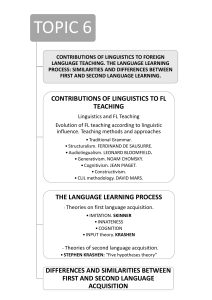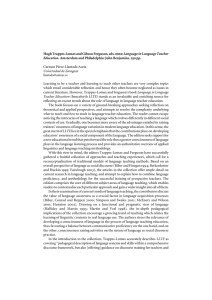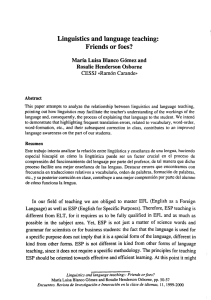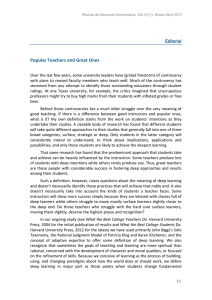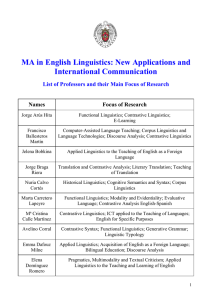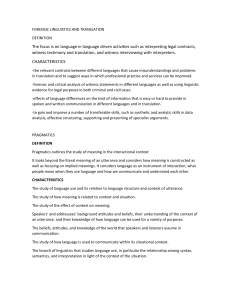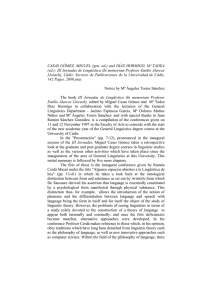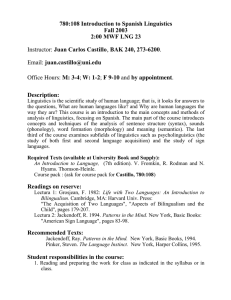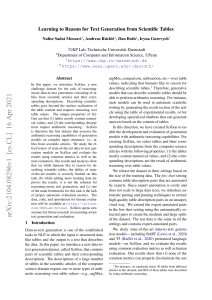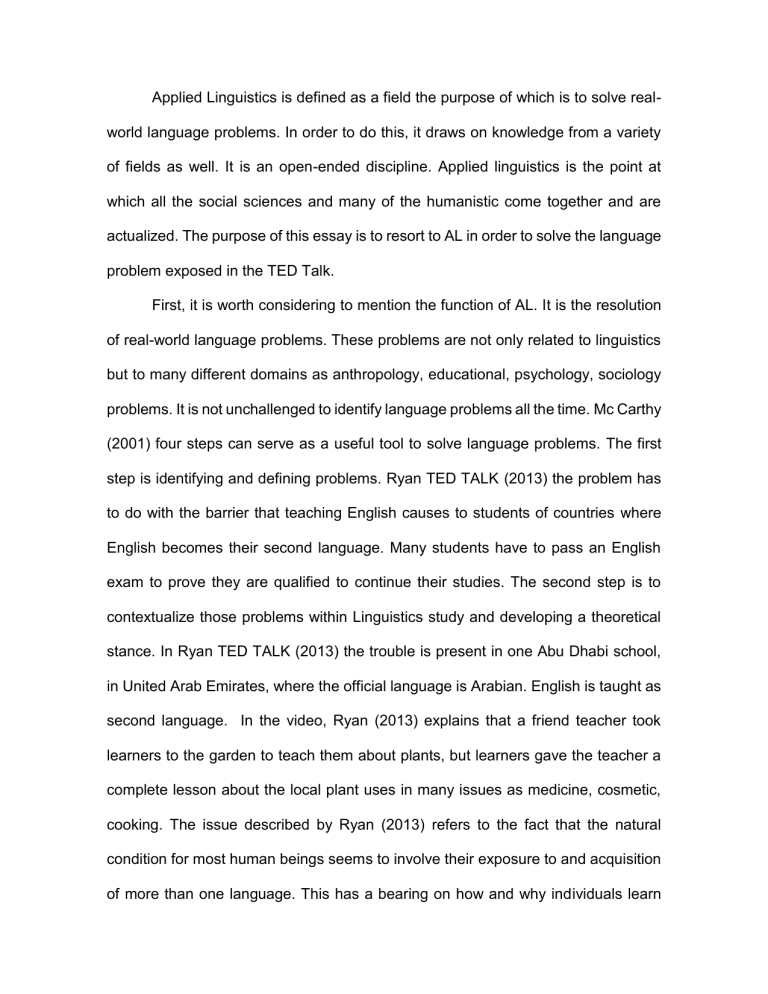
Applied Linguistics is defined as a field the purpose of which is to solve realworld language problems. In order to do this, it draws on knowledge from a variety of fields as well. It is an open-ended discipline. Applied linguistics is the point at which all the social sciences and many of the humanistic come together and are actualized. The purpose of this essay is to resort to AL in order to solve the language problem exposed in the TED Talk. First, it is worth considering to mention the function of AL. It is the resolution of real-world language problems. These problems are not only related to linguistics but to many different domains as anthropology, educational, psychology, sociology problems. It is not unchallenged to identify language problems all the time. Mc Carthy (2001) four steps can serve as a useful tool to solve language problems. The first step is identifying and defining problems. Ryan TED TALK (2013) the problem has to do with the barrier that teaching English causes to students of countries where English becomes their second language. Many students have to pass an English exam to prove they are qualified to continue their studies. The second step is to contextualize those problems within Linguistics study and developing a theoretical stance. In Ryan TED TALK (2013) the trouble is present in one Abu Dhabi school, in United Arab Emirates, where the official language is Arabian. English is taught as second language. In the video, Ryan (2013) explains that a friend teacher took learners to the garden to teach them about plants, but learners gave the teacher a complete lesson about the local plant uses in many issues as medicine, cosmetic, cooking. The issue described by Ryan (2013) refers to the fact that the natural condition for most human beings seems to involve their exposure to and acquisition of more than one language. This has a bearing on how and why individuals learn and use more than one language. Included in this area topics such as bilingualism, multilingualism, multiculturalism are included. The Applied Linguistics is concerned with understanding what it means to be bilingual, how bilingualism happens, where (in addition to the classroom) bilingualism may be acquired and what bilingualism does to the community in which it exists in human, ecological, social, political and economic terms. Thirdly, the following step is to harness appropriate resources for the exploration of possible solutions. According to Brown (2007) the native language of learners has a strong influence in the acquisition of the target language. For this reason, one possible solution to this problem is the integration of mother tongue when learning a second language to foster the expansion of other languages ideas. Mother tongue as a part of a specific culture helps to transform language barriers into leaning opportunities. The final step is to evaluate the proposed solutions. To conclude, teachers´ pedagogical function is to preserve heritage and respect differences between cultures and mother languages. Other cultures are priceless value and barriers must be defeated. In Ryan´s words: “Pay attention to your language. Use it to spread great ideas ". References Ryan, P. (2013, July 25). YouTube [Video]. YouTube. McCarthy, M., (2001). Issues in Applied Linguistics. Cambridge University Press. Brown, D. (2007). Teaching by principles. Pearson Education. Educational Linguistics is oriented to innovative research work about: using language in classrooms, literacy development, language learning, planning language usage in educational settings and assessing language knowledge. It is undeniable that work on Educational Linguistics has priorities which vary according to the context, and this includes challenges, local educational policies and participants’ profiles (knowledge and skills development in both students and teachers). The EPOSTL (2007) is a programme oriented to student teachers who need to know about language during their training courses to be effective in their desire to achieve the EFL course goals in their practice. The purpose of this paper is to compare it to the professional development/experience of the author of this paper as a teacher in her local sociocultural context. First of all, it is highly important to define this programme. The European Portfolio for Student Teachers of Languages (EPOSTL) (2007) is a document for students undergoing initial teacher education. It will encourage them to reflect on their didactic knowledge and skills necessary to teach languages, helps them to assess their own didactic competences and enables them to monitor their progress and to record their experiences of teaching during the course of their teacher education. A second factor to bear in mind is the educational context where the teaching and learning process co-exist. ‘Decisions relating to teaching are strongly influenced by the educational and social context in which teachers work. This context is mainly predetermined by the requirements in the national and/or local curricula’ (EPOSTL, introduction). Marco Avellaneda School is a public school located in San Jose de Metan-province of Salta. Its students´ English level is A1 according to the CEFR (2001). It is possible to adapt the EPOSTL to this context due to the fact that national and local curricula are flexible and allow the teacher to modify her practice and her syllabus considering her students‘ needs that might constantly change along the school year. The EPOSTL will help this teacher to reflect on aspects related to teaching in general and seek for positive and negative experiences that improve her daily practice. In close relationship with the educational context, the EPOSTL has got some aspects that the author claims are the most important for her. These aspects are: 1. I can present language content (new and previously encountered items of language, topics etc.) in ways which are appropriate for individuals and specific groups of learners: as mentioned above, it is evidenced that analyse and specify learners´ needs allows users of the target language to be engaged in the language and helps them to be receptive and be responsible for and conscious about their learning process. 3. I can relate what I teach to current events in local and international contexts. It is of paramount importance to contextualize the content so students feel identified to this known content and learn it better. To conclude, the EPOSTL is a great tool to be implemented in any educational context because it guides teacher to assess themselves and develop professional awareness regarding to their practices at teaching a language. References David Newby, D., Allan, R., Fenner, A., Jones, B., Hanna Komorowska, H., & Soghikyan, K. (2007). EPOSTL. European Portfolio for Student Teachers of Language. A reflection tool for language teacher education. Council of Europe. Retrieved from: https://www.researchgate.net/publication/237537978_European_Portfolio_for_Stud ent_Teachers_of_Languages Common European Framework (2001). Modern languages: learning, teaching, assessment. A common European framework of reference. Strasbourg: Council of Europe and Cambridge University Press. Common European Framework (2001). Modern languages: learning, teaching, assessment. A common European framework of reference. Strasbourg: Council of Europe and Cambridge University Press. The European language portfolio (ELP) is part of the Council of Europe´s Common European Framework for Language teaching (CEF 2001) and it reflects all its major concerns as regards modern language projects since the 1970s. It has a pedagogical and reporting function which allows students to collect evidence of their learning progress, learn to reflect upon their learning process and develop cross-cultural awareness as they learn foreign languages.
